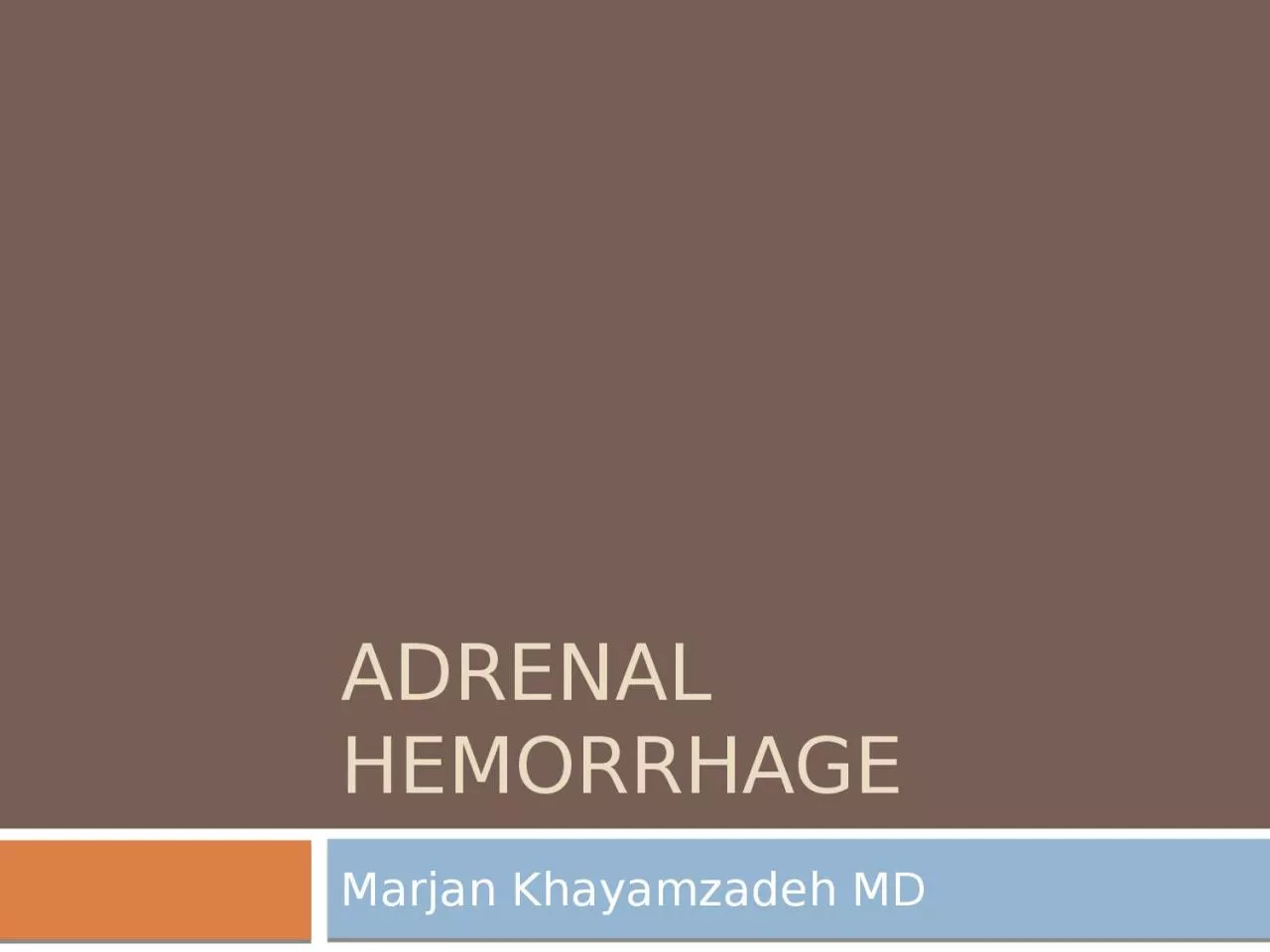

Khayamzadeh MD Retrospective analysis of 70 patients with bilateral adrenal masses presenting to a single tertiary care endocrine centre from western India 20022015 The most common aetiology ID: 935222
Download Presentation The PPT/PDF document "Adrenal hemorrhage Marjan" is the property of its rightful owner. Permission is granted to download and print the materials on this web site for personal, non-commercial use only, and to display it on your personal computer provided you do not modify the materials and that you retain all copyright notices contained in the materials. By downloading content from our website, you accept the terms of this agreement.
Slide1
Adrenal hemorrhage
Marjan
Khayamzadeh
MD
Slide2Slide3Slide4Retrospective analysis of 70 patients with bilateral adrenal masses presenting to a single tertiary care endocrine centre from western India (2002–2015).
Slide5The most common
aetiology
was
pheochromocytoma
(40
%)
tuberculosis (27.1
%)
primary
adrenal lymphoma (PAL) (10
%)
metastases (5.7
%)
non-functioning
adenomas (4.3
%)
Slide6primary bilateral
macronodular
adrenal hyperplasia (4.3%)
and others (8.6%)
Slide7Slide8Slide9The
diagnosis should
be suspected in any complex
highly stressful illness
, in the
postoperative period,
or in
the presence of a
coagulopathy
in conjunction
with hypotension
, fever, or
electrolyte disturbances
.
Slide10Slide11Case:
An healthy 70-year-old man radical
cystectomy
,
lymphadenectomy
, were performed.
On the
fifth postoperative day
, fever, nausea, vomiting, and increased wound drainage developed.
He became
hypotensive
and was found to have
leukocytosis
, thrombocytopenia (35,000 platelets/mm3),
hyponatremia
, and
hyperkalemia
.
Slide12Intra-abdominal sepsis causing
disseminated intravascular coagulation
was suspected.
CT examination revealed bilateral
high-density
adrenal gland masses, characteristic of
recent adrenal hemorrhage.
A follow-up CT scan obtained
13 days
after the initial scan showed a slight decrease in the
size
and
density
of the adrenal masses.
Slide13Slide14In the five cases reported herein, no definite
histologic
proof of adrenal hemorrhage was
available.The
diagnosis was based on the initial CT appearance of
high-density
adrenal gland masses and their
decreasing size and density
on follow-up scans.
Slide15several clinical and pathologic conditions seem to be
associated with
adrenal hemorrhage in adults. One commonly associated condition is
high-level
corticotropin
stimulation
of the adrenal glands which might occur during the course of myocardial infarction, sepsis, pulmonary embolus, surgical stress, postoperative complications, shock, and other such illnesses.
Slide16Adrenal hemorrhage usually occurs within the
first 3 weeks
of a medical illness or the postoperative
period.
Anticoagulation and
coagulopathies
are also common predisposing risk factors for adrenal
hemorrhage. lupus anticoagulant could induce adrenal venous
thrombosis
and thus lead to
adrenal
hemorrhagic infarction.
Slide17The symptoms and signs of bilateral adrenal hemorrhage are nonspecific. Chest, back, flank, or abdominal pain, usually associated with fever, is common. Hypotension is frequently a
preterminal
finding. Biochemical evidence of adrenal insufficiency (such as
hyponatremia
,
leukocytosis
, acidosis,
hyperkalemia
, and
azotemia
) can be absent or, if
present, attributed to the concomitant illness. A sudden
decrease in hemog
lobin concentration and
hematocrit
has also been described.
Slide18The diagnosis necessitates a high index of suspicion and can be
confirmed
by the use of CT of the abdomen. Once the diagnosis is suspected, lifesaving steroid replacement should be initiated without delay.
Slide19Slide20a 64-year-old man with
polycythemia
vera
found to be unresponsive with fever, hypotension, tachycardia, and hypoglycemia.
Electrocardiogram showed ST-elevation with elevated
troponin
, hemoglobin,
prothrombin
time, and partial
thromboplastin
time.
Slide21He required aggressive ventilator and
vasopressor
support. Despite primary coronary intervention, he remained
hypotensive
. Random
cortisol
level was low. He received stress dose hydrocortisone with immediate hemodynamic stability.
BAH was highly suspected and was confirmed by non-contrast abdominal computed tomography.
Slide22The
pathophysiology
of BAH is still unknown. However, due to particular anatomy of its vascular supply adrenal gland is at risk of venous congestion and thrombosis. About 50 to 60 small branches from the 3 suprarenal arteries feed into a
subcapsular
plexus that drains into the
medullary
sinusoids by few small
venules
forming a large central vein.
Slide23The transition from artery to capillary plexus is abrupt and constitutes a ‘vascular dam’. This complex
microvascular
system of the adrenal glands predispose them to be vulnerable to
thrombosis
or
hemorrhagic necrosis.
Slide24Conclusion
This case illustrates the importance of being aware of the
risk factors
for BAH in
critically ill patients
. The presence of
hypercoagulability
and refractory hypotension should raise clinical suspicion of BAH. Abdominal CT scan, while valuable in establishing diagnosis of adrenal hemorrhage, must not delay initiation of lifesaving corticosteroid therapy.
Slide25CASE REPORT (1992): an 85-year-old man with PV associated with
thrombocytosis
who presented with
syncope and abdominal tenderness.
They concluded that
coagulopathy
is what appears to link PV with BAH.
Slide26CASE REPORT(2011):a 56-year-old man with PV who presented with
epigastric
discomfort, nausea, and
vomiting.splenomegally
was noted.
A well defined mass measuring 4*5*5.5 cm in right adrenal and a mass of 4*3*2cm in left adrenal were detected.
Basal
cortisol,ACTH
and ACTH
stimulasion
test confirmed adrenal insufficiency.
Slide27BAH was attributed to
high
thrombocyte
count.
The case was considered to be bilateral adrenal hemorrhage associated with PV and consequent adrenal insufficiency and
prednisolone
was started.
Slide28Slide29A 54-year-old woman presented with sudden
epigastralgia
and left back pain. She had no significant history. Abdominal CT showed left adrenal enlargement and
haemorrhage
. Hydrocortisone therapy was started to prevent adrenal
insufficienc
. On the second hospital
day, abdominal CT showed additional right adrenal
enlargement and
haemorrhage
.
Slide30No specific findings were detected by bilateral adrenal angiography. 6 to 12 months later, abdominal CT showed decreased bilateral adrenal
haemorrhage
.
In parallel with this, repeated blood examinations showed improvement of ACTH and
cortisol
levels. The dosage of oral hydrocortisone replacement was gradually decreased and then stopped at 6 months after discharge.